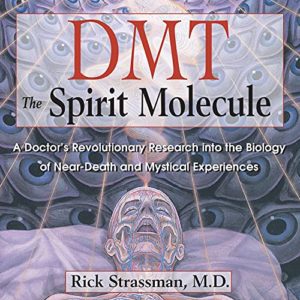If you can’t get the bodywork you are used to because of the COVID-19 shutdown, you aren’t alone. Fortunately, there are a number of easy techniques you can perform on yourself to provide some pain relief. While they can’t replace the benefits of a full SET treatment, they will help you in the meantime until you can schedule your next session. You can do these techniques using a combination of foam rollers, lacrosse balls and your own hands.
Note: With all of these techniques, please make sure to only use enough pressure and depth to feel a good stretch on the tissue. Lighter pressure held for longer period of time will get you better results than hard pressure. As my teacher likes to say “sink in, sink in, sink in.” If you feel any pain, use less pressure or skip the area.
Pain Between Shoulder Blades
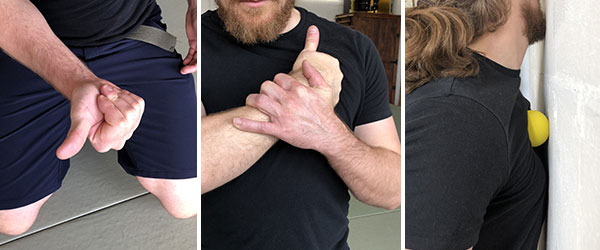
Working the pectoral muscles in the upper chest will help to ease pain between the shoulder blades and decrease rounding of the shoulders that can come from sitting at a computer desk or using a cell phone.
Use a soft fist (below left) of the opposite hand to work the upper chest working from the center out. You can also use a lacrosse ball because it is hard enough to engage your fascia, but feel free to experiment with balls of different densities. You can also perform this technique working against a wall with a lacrosse ball and using your bodyweight instead of your arm muscles to work the tissue (below right).
Neck and Back Pain
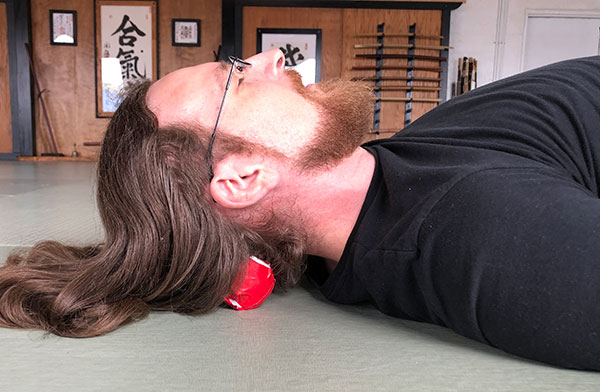
The suboccipitals (base of the skull) area is related to neck, head, and back pain and can affect the fascial planes of the back all the way down to the soles of the feet.
Lay on the floor face up. Place a “peanut” (Don’t have a peanut? Watch our YouTube video on how to make your own from two lacrosse or tennis balls) or a still point inducer at the base of the skull. Take some relaxing full breaths through the nose and let the weight of your head do the work to release the tissue. I generally won’t spend more than a minute doing this to avoid over treating the area but this is a go-to for me if I have a headache.
Tight Upper-back and Shoulders

Using a foam roller on the back is a great way to release the back muscles. It can also be used to stretch the front of the body and release tissue in the shoulders.
Lie face-up on the ground with your knees bent and your feet planted on the ground about hip-width apart. Put the foam roller under the middle of your back perpendicularly and extend and flex your knees and hip to roll it up and down your spine. When you get to your shoulders, you can rest there and raise your arms over your head to get a good stretch in your shoulder and extend your thoracic vertebra and ribs, releasing the frontal myofascial planes.
Tight Hamstrings
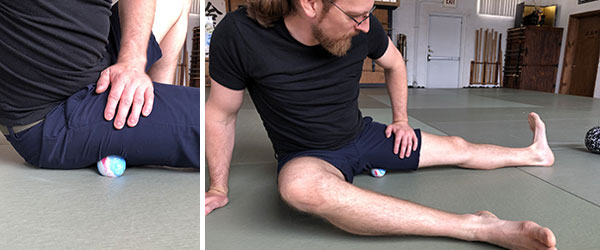
Sit on the ground and raise yourself up with your hands long enough to position the lacrosse ball on the ground under the hamstrings of one leg. Use your bodyweight to apply pressure to release the muscles. Don’t use your full bodyweight, just enough to engage the muscles.
Tight Hip and Thigh Muscles

Position your body so the foam roller is on the ground and the body part you want to roll out is in contact with the roller and your bodyweight is on top. Use your body weight to apply pressure to release the muscles. For the IT band and adductor, a grooved foam roller is great because it applies pressure adjacent to the tendon to release the attached muscle, rather than on the tendons, which generally causes a lot of sensation but not much change in the tissue. Don’t use your full bodyweight, just enough to engage the tissue.
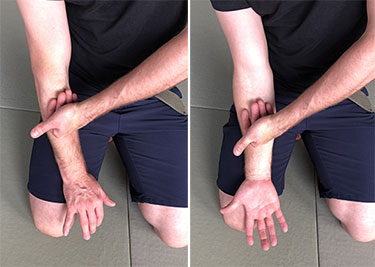
Stiff Forearms
Release forearm stiffness by applying pressure with a soft fist.
Sit on a chair or on the floor. Rest one forearm on your thigh and use a soft fist from the other arm to work into the tissue on the front of your forearm, starting near the elbow and working towards the hand. Repeat on the back side of the arm. You can use oil or lotion to get a glide on the tissue. I use this one a lot, especially if I’ve been working with my hands.
Disclaimer: Product links in this article are offered to provide examples of products only. I do not specifically endorse the specific linked products, nor have I received any payment or incentive to endorse these specific products.

